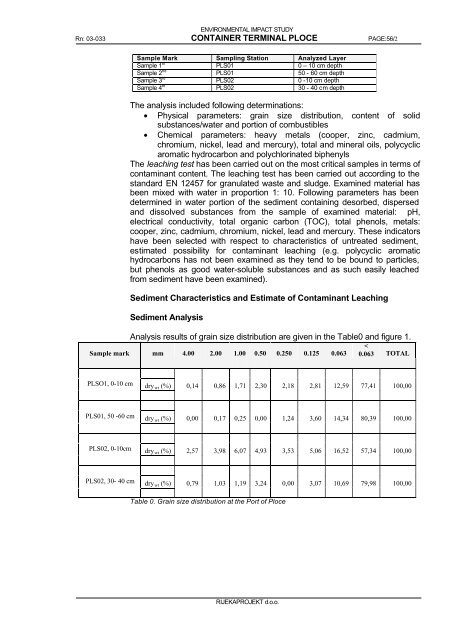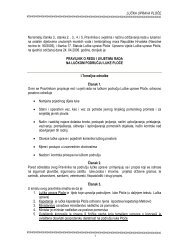HEADING PAGE - port of ploce authority * welcome
HEADING PAGE - port of ploce authority * welcome
HEADING PAGE - port of ploce authority * welcome
Create successful ePaper yourself
Turn your PDF publications into a flip-book with our unique Google optimized e-Paper software.
ENVIRONMENTAL IMPACT STUDY<br />
Rn: 03-033 CONTAINER TERMINAL PLOCE <strong>PAGE</strong>:56/2<br />
Sample Mark Sampling Station Analyzed Layer<br />
Sample 1 st PLS01 0 – 10 cm depth<br />
Sample 2 nd PLS01 50 - 60 cm depth<br />
Sample 3 rd PLS02 0 -10 cm depth<br />
Sample 4 th PLS02 30 - 40 cm depth<br />
The analysis included following determinations:<br />
• Physical parameters: grain size distribution, content <strong>of</strong> solid<br />
substances/water and <strong>port</strong>ion <strong>of</strong> combustibles<br />
• Chemical parameters: heavy metals (cooper, zinc, cadmium,<br />
chromium, nickel, lead and mercury), total and mineral oils, polycyclic<br />
aromatic hydrocarbon and polychlorinated biphenyls<br />
The leaching test has been carried out on the most critical samples in terms <strong>of</strong><br />
contaminant content. The leaching test has been carried out according to the<br />
standard EN 12457 for granulated waste and sludge. Examined material has<br />
been mixed with water in pro<strong>port</strong>ion 1: 10. Following parameters has been<br />
determined in water <strong>port</strong>ion <strong>of</strong> the sediment containing desorbed, dispersed<br />
and dissolved substances from the sample <strong>of</strong> examined material: pH,<br />
electrical conductivity, total organic carbon (TOC), total phenols, metals:<br />
cooper, zinc, cadmium, chromium, nickel, lead and mercury. These indicators<br />
have been selected with respect to characteristics <strong>of</strong> untreated sediment,<br />
estimated possibility for contaminant leaching (e.g. polycyclic aromatic<br />
hydrocarbons has not been examined as they tend to be bound to particles,<br />
but phenols as good water-soluble substances and as such easily leached<br />
from sediment have been examined).<br />
Sediment Characteristics and Estimate <strong>of</strong> Contaminant Leaching<br />
Sediment Analysis<br />
Analysis results <strong>of</strong> grain size distribution are given in the Table0 and figure 1.<br />
Sample mark mm 4.00 2.00 1.00 0.50 0.250 0.125 0.063<br />
PLSO1, 0-10 cm<br />
PLS01, 50 -60 cm<br />
PLS02, 0-10cm<br />
PLS02, 30- 40 cm<br />
RIJEKAPROJEKT d.o.o.<br />
<<br />
0.063 TOTAL<br />
dry wt (%) 0,14 0,86 1,71 2,30 2,18 2,81 12,59 77,41 100,00<br />
dry wt (%) 0,00 0,17 0,25 0,00 1,24 3,60 14,34 80,39 100,00<br />
dry wt (%) 2,57 3,98 6,07 4,93 3,53 5,06 16,52 57,34 100,00<br />
dry wt (%) 0,79 1,03 1,19 3,24 0,00 3,07 10,69 79,98 100,00<br />
Table 0. Grain size distribution at the Port <strong>of</strong> Ploce



